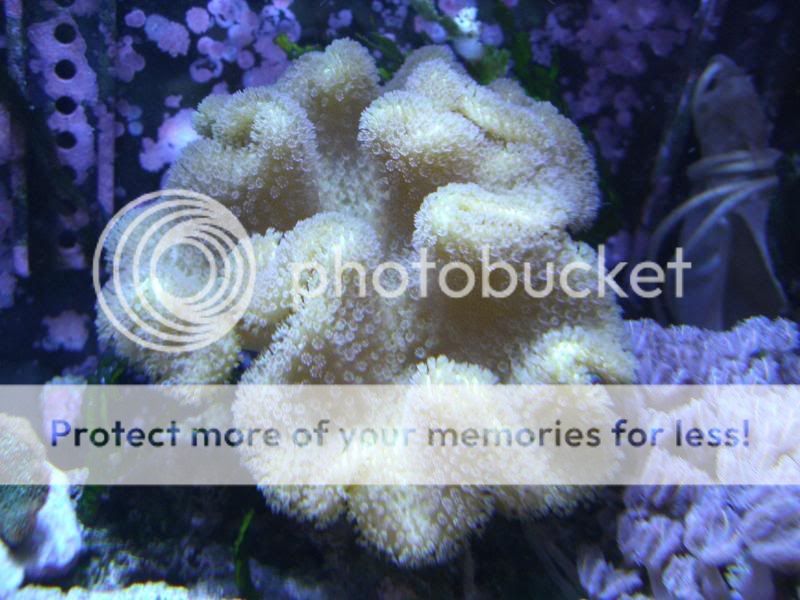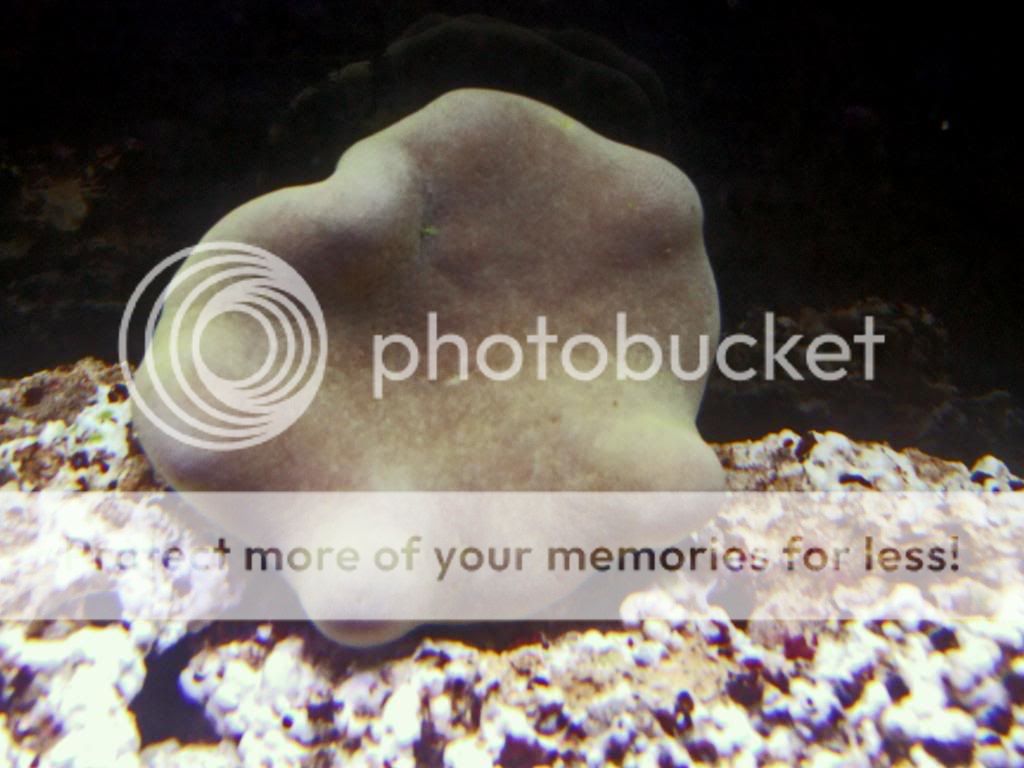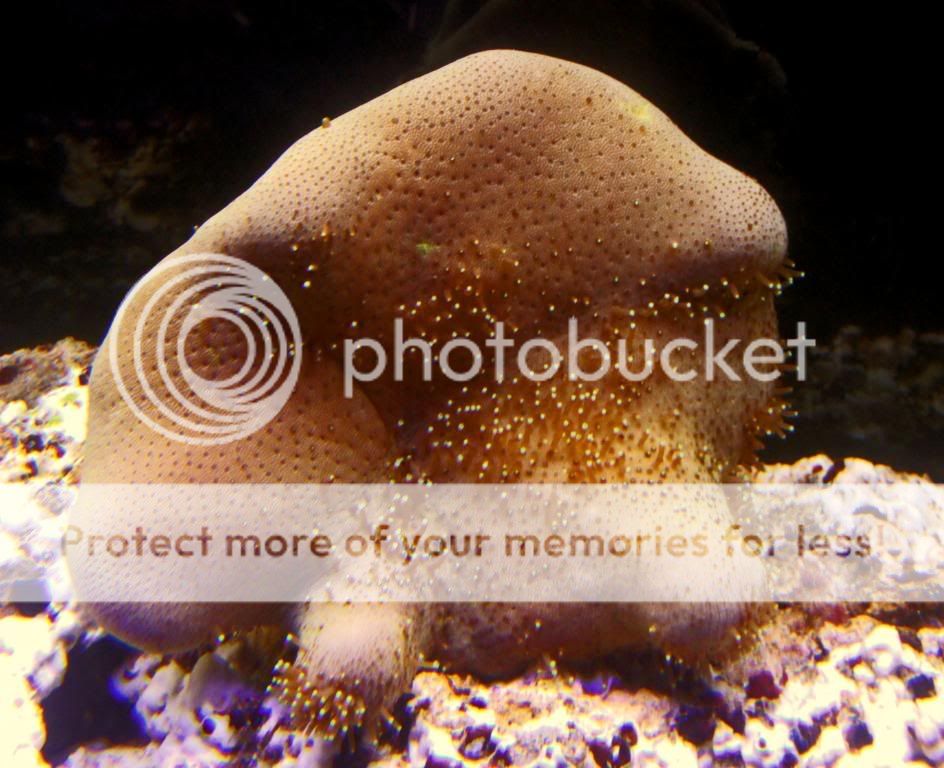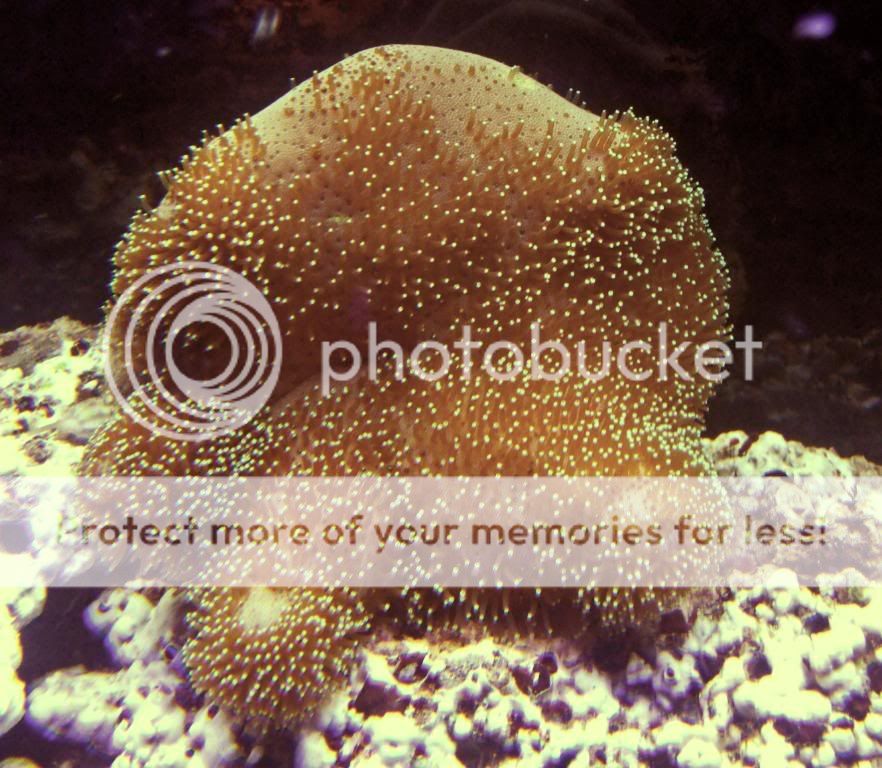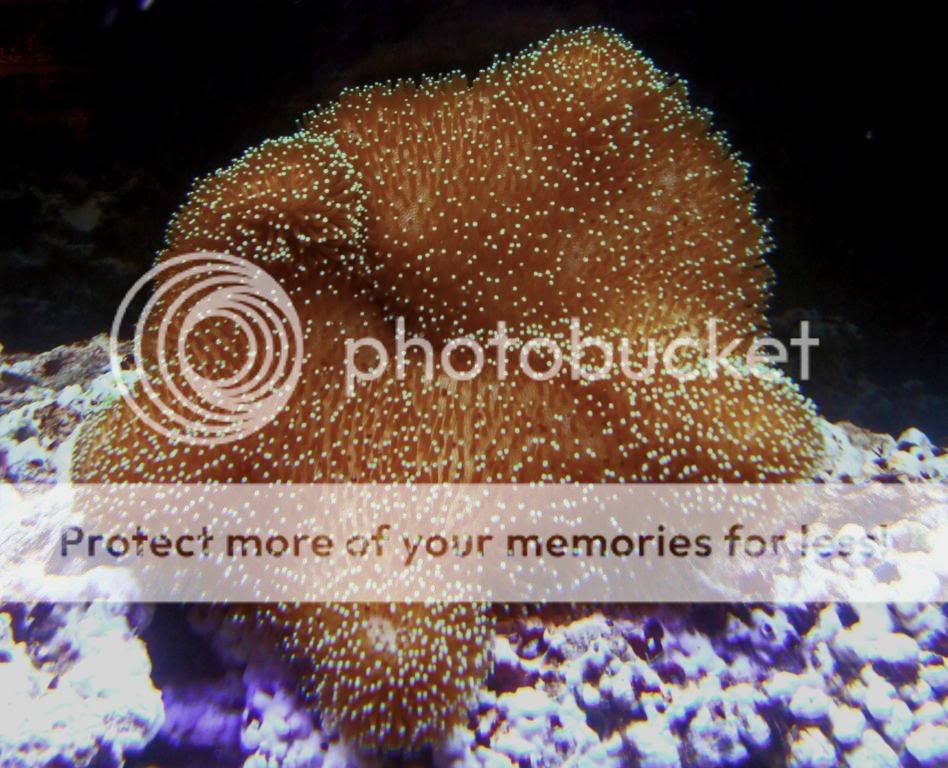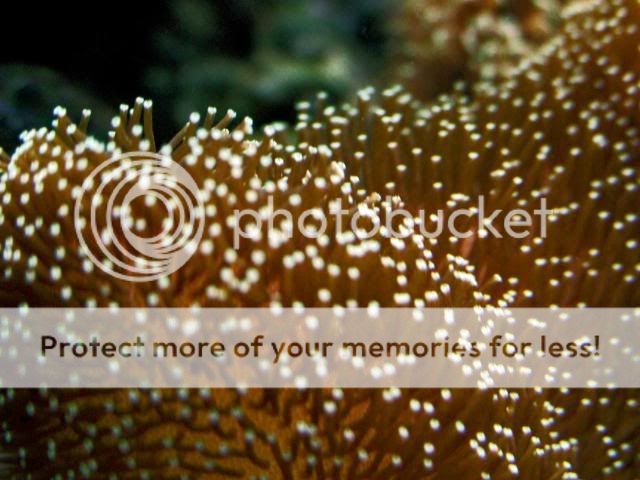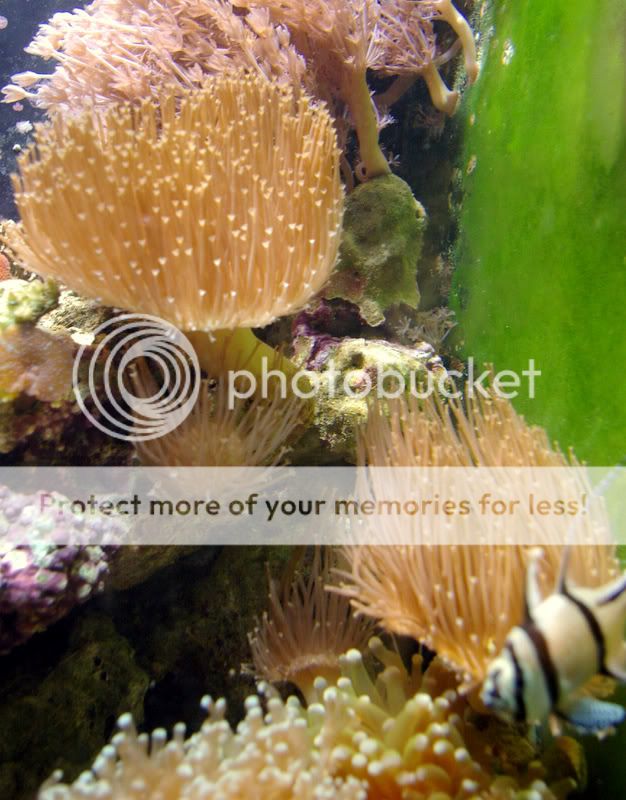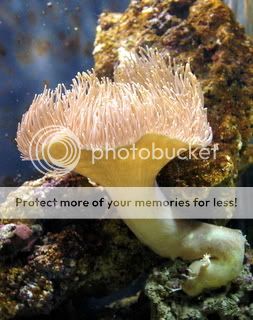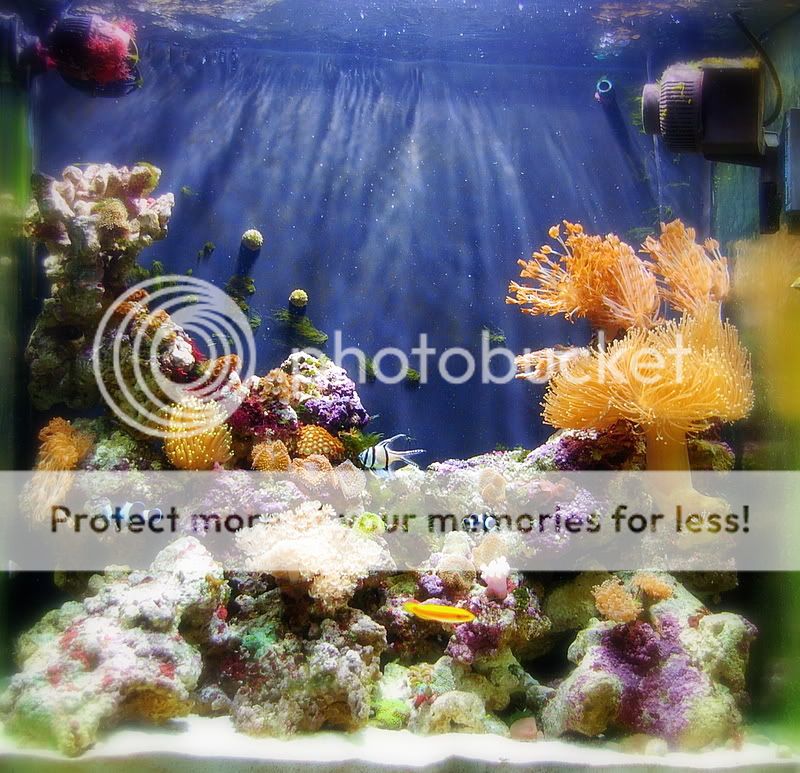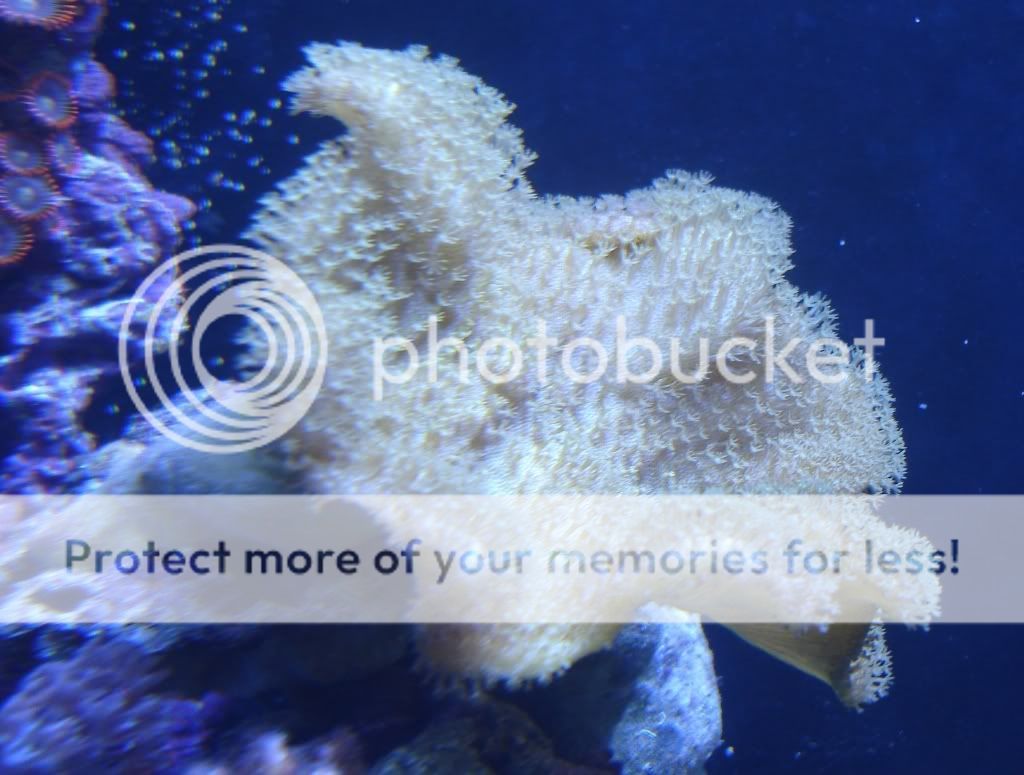At what does Eric Bourneman have to say about our Coral of the Week
family : Alcyonaria genus : Sarcophyton common species : glaucum, ehrenbergi, trocheliophorum , and others Common names : leather, toadstool, mushroom, trough
The durability and beauty of leather. How many times have you heard leather described this way? Well, I guess what works for the poor bovines sacrificing their hides for our seating also applies to the leather corals of the sea. These common corals are also known as Alcyonarians, octocorals, flower animals, soft corals, and a host of other nondescript names. They are very hardy animals, and can be absolutely stunning to look at, much like the optional leather interior...I hear it is also the reason for "that new tank smell." Eeeewwww...bad joke! It has recently been suggested that the term "toadstool" be used to describe the members of the genus Sarcophyton . While the name "leather coral" is overused and describes many soft corals, so is their other common name of "mushroom coral." Therefore, I am going to eliminate the nuances, and refer to them as what they are; Sarcophyton species. Sarkos is Greek for flesh and phyton means creature. Flesh creature. Indeed.
Despite large fields of soft coral reef throughout the Indo-Pacific, these corals are not hermatypic, and are usually not a dominant species. Still, 36 described species of Sarcophyton are known to exist in the world with many more likely to be discovered. However, along the east coast of Africa, soft corals may predominate in number and mass over scleractinian (stony) corals. Sixty percent or more of the coral coverage of many reefs of Africa are populated by soft corals consisting mainly of Sarcophyton , Sinularia , and Lobophytum .
The Red Sea also has prolific numbers of soft corals, including many species of Sarcophyton .
Sarcophytons are polytrophic, meaning they get nutrition from multiple sources. Because the polyps of these corals do not possess strong nematocysts, prey capture is restricted to microplankton, and it is likely aided by mucus secretion and ciliate absorption. Trapped particles are carried from the highly efficient filter feeding tentacles into the polyp mouth by ciliary action. More likely to be a significant source of nutrition to these corals is direct absorption. Sarcophytons are quite capable of substantial uptake of nutrients direct from the sea water into their cells. Finally, all known Sarcophytons are symbiotic, and have large numbers of zooxanthellae in their tissues. Although many octocorals are very brightly colored, members of the toadstool leather corals are quite drab by comparison. They are usually brown or cream colored, owing to the large number of symbiotic dinoflagellates contained near their surface. Some species may be yellow or lemony cream colored, and those commonly available in the hobby are most likely collected from the waters around the island kingdom of Tonga.
Sarcophytons are octocorals which are characterized by having polyps with eight tentacles surrounding the mouth. The tentacles themselves are feathery, with small side branches called pinnules along the length of each tentacle arm. The bodies of soft corals are non-calcareous, in that they do not secrete a limestone skeleton to enclose their polyps. Instead, the form and shape of the corals is maintained with small calcium skeletal pieces within their body called sclerites. It is the distinct appearance of sclerites that allow for the accurate identification of most soft corals. All species of octocorals, including Sarcophyton , reproduce sexually through planulae, as well as asexual reproduction through cloning or fragmentation. The corals are mushroom shaped, with a thick heavy stalk and a "cap," called a capitulum. The capitulum is sometimes rounded, but often folded, funnel shaped or cup shaped. The top of the capitulum is called the polyparium, and it is the surface from which the polyps arise. It is smooth in all Sarcophyton species. The polyps are of two types: siphonozooids, which are secondary almost invisible polyps that promote water circulation within the colony; and autozooids, which are the primary polyps that extend from the capitulum on long thin stalks with the eight feathery pinnate tentacles at the ends. These are the feeding polyps, and they are completely retractable. The polyps of most Sarcophyton species are retracted at night and extend at first light. Within the coral, the sclerites are club shaped spindles, sometimes adorned with protuberances called tubercles.
After such depth describing the exact physiologic appearance of Sarcophyton , it must seem like there is a copious amount of information on these corals. Actually nothing could be farther from the truth. Most soft corals, including Sarcophytons , were first described during early expeditions to the Great Barrier Reef early this century. Earlier references and initial descriptions were first made in the mid to late nineteenth century, and many have not been revised since that time. In fact, very little interest has been shown in the octocorals until it was determined that they produced a number of very interesting and unique chemical compounds. While these will be discussed in depth later, suffice to say that it is always when man finds something of personal interest that exploitation and research are the normal result. I hope that these corals are not systematically eliminated from already threatened reef ecosystems because they may show a chance of some undetermined pharmaceutical benefit.
Rant aside, it is interesting that octocorals are normally identified by colony growth form, polyps (kind, distribution and structure) and the sclerites. Sarcophytons are identified by removing a piece of tissue and dissolving it in household bleach to extract the sclerites. The small calcium pieces are then compared to existing records in order to identify the coral. Of course, to those keeping these corals in their aquariums, this procedure is of limited value and of questionable importance in any event. The fact that the entire taxonomy of the genus is far out of date and completely inadequate (even by the ready admission of Alcyonarian taxonomists) and that the time between most studies of octocorals have typically been measured in decades rather than years or months, means that positive identification is marginal at best.
Armed with the knowledge that most hobbyists will never be able to accurately say anything more than, "I'll take that Sarcophyton over there," it is perhaps more appropriate to discuss the corals as they relate to our aquariums. Leather corals became quite popular in the early Berlin systems in Europe. Peter Wilkens wrote about these "flower animals," and began bringing them back with him to raise in aquaria. They turned out to be quite hardy and successful, growing under even under the relatively primitive conditions of the time. As the reef hobby spread to the U.S., these were among the most commonly available corals in the trade.
They remain very common today, and are often hailed as "starter" corals. Although the "Yellow Tongan Leathers" are much more difficult to keep healthy (probably since they come from cooler waters), the other species are all very hardy. They adapt well to tank conditions. Not demanding in terms of water quality or water flow, most fare extremely well in captivity. Despite being primarily located in bright light environments, the toadstool leathers grow rapidly even under normal fluorescent lighting. Metal halide light will create veritable "monster-sized" leather corals in less than a year. They do not require large amounts of calcium, although iodine seems to be quite important to their health. Most new hobbyists begin keeping corals with some sort of soft coral, and Sarcophytons are readily available and heartily recommended by books, stores, hobbyists, magazine articles and suppliers.
Sarcophytons all shed a surface layer of dead waxy tissue from their surface. This is a regenerative action, and serves to rid the surface layers of algae and waste. Strong currents will help limit the frequency of this shedding. During such times, many people observe a sick looking and withdrawn Sarcophyton and assume that the coral is on its last leg, or that something is drastcially wrong in their tank. After the shed, however, the corals reexpand in full glory, usually larger and healthier than ever.
There are several species of planaria, nudibranchs and parasites that tend to fed on the coral tissue, and a simple five minute dip of the coral into freshwater of the same temperature and pH is usually all that is required to remove the parasites and predators. Some species of crustaceans may also feed on the tissue. There are, however, occasions when the tissue of Sarcophyton becomes necrotic, and starts to deteriorate and become "cheesy." This is normally caused by tank conditions, the lack of a required trace element, heavy sedimentation, the presence of a toxin, or improper lighting. Necrotic areas can be trimmed off with a razor blade. I have also treated a necrotic and fragile yellow Sarcophyton with an extended Lugol's dip of ten drops of Lugol's solution to a liter of water for four hours. The coral seemed immediately relieved, and healed within 24 hours of being replaced into the tank.
In fact, Sarcophytons are extremely "cuttable." All sections of the coral are totipotent, meaning that a slice of the coral attached via glue or banding to a substrate will reattach and form another complete colony fairly quickly. There is very little risk involved, and almost any type of slicing is possible to create new colonies. It can be divided along the length and across the top like a pie, or the cap can be sliced off and reattached to a new substrate base. Much captive propagation of soft corals is accomplished in this manner, and it is simply as easy as "slice and stick," or "cut and paste."
With so much hearty recommendation of these corals, especially with noted aquarists affirming that the corals may be housed in "mixed" displays of stony and soft corals, it becomes necessary to examine the competitive strategies of Sarcophyton in nature. Soft corals are unique in that they are not grazed upon by many predators. Since the tissue is exposed and unprotected by a rigid skeleton, it would seem likely that these corals would be instant easy snacks, even with the sharp sclerites inside. However, Sarcophytons are not preyed upon often, and it is apparent that they must taste incredibly bad to most reef animals. They also seem extremely competitive with stony corals in the areas where both types of coral are found. As it turns out, most stony corals do not chemically recognize soft corals are "enemies," and they do not use extracoelenteric digestion on soft corals in intimate contact. Although some stony corals can inflict localized damage on some soft corals with sweeper tentacles, this damage is quite limited in scope. Thus soft corals are able to easily grow over the stony corals and smother them.
More importantly, soft corals have chemical defense systems. They are capable of producing a bewildering array or toxic chemicals. Some of these are used in the sexual cycle of reproduction, some are used as species recognition chemicals, some are used to discourage predation, and others seem to be used to capture space, either in a defensive or aggressive manner. The compounds not only discourage and inhibit the growth and colonization of many stony corals including Pavona, Porites, Galaxea, Stylophora and Acropora , but they may even cause death to nearby corals without even directly contacting them. Fish and corals put in tanks with the extract from soft corals could cause death within thirty minutes. As it turns out, some genera of soft corals are inherently more toxic than others, with a degree of variability between species. Sarcophytons are categorized as those considered immediately and most toxic. In fact, Sarcophytons are producers of over fifty different chemical compounds, many of them unknown and of uncertain chemical makeup. By far the largest number of compounds belong to a class of chemicals know as terpenes. These were compounds previously thought to exist only in terrestrial plants as predatory deterrents. It would seem that the term "flower animal" is beginning to be even more appropriate. Some predatory nudibranchs even store the toxins from S. trocheliophorum for their own defense systems. Specifically, the toxin of this coral is called sarcophytoxide. Sarcophine is another terpenoid toxin isolated from Sarcophyton glaucum . These compounds are so effective that in almost no cases will stony corals be unaffected by them, and growth inhibition, local necrosis and death usually ensue contact of Sarcophyton corals. In other words, in a war between soft corals and hard corals, the soft corals will almost invariably be victorious.
Given this information, and the obvious complications that arise in a close system aquaria, it should not be surprising that there are beginning to be many reports of mysterious unexplainable recession of stony corals in tanks housing large specimens or many types of soft corals. Some stony corals seem infinitely more sensitive to the terpenoid compounds of Sarcophyton . Others seem comparatively unaffected. However, the obvious zonations that occur in the wild should be carefully considered, and it is my opinion that soft corals and hard corals should be minimally intermixed, if at all. Sarcophyton , being considered a highly toxic species, does not seem to be a wise choice for displays with stony corals. The soft corals are all beautiful and hardy corals in their own right, but if we as hobbyists begin to learn about habitats and the physiology and biology of our captive corals, we must also bear the responsibility of maintaining proper conditions for them. I feel that foresight should be used in planning reef aquariums, and it should be decided in advance if an aquarium will be a relatively easy and quite beautiful display of soft corals, or if it will house stony corals. Sarcophytons are exceptional corals that are fast growing, hardy, and reproducible. This makes them highly desirable, but just as we would not keep a parrotfish with our stony corals, Sarcophyton deserves similar respect for its own health... and the health of all the other inhabitants in the tank. The risk of one damaging other corals or killing fish is not worth the selfish motivation to keep all the species of a reef within one display. At least for me, leather is not optional.
Eric Borneman (Eric Hugo)
References:
Benayahu, Y., and Y. Loya. 1981. Competition for space among coral-reef sessile organisms at Eilat, Red Sea. Bull. Mar. Sci. 31: 514-22.
Coll, J.C., and P.W. Sammarco. 1988. The role of secondary metabolites in the chemical ecology of marine invertebrates: a meeting ground for biologists and chemists. Proc. Sixth Int'l. Coral Reef Symp. 1: 167- 73.
Coll, John C., and Paul W. Sammarco.1986. Soft corals: chemistry and ecology. Oceanus 29: 33-7.
Coll, John C., Stephane La Barre, Paul W. Sammarco, William T. Williams, and Gerald J. Bakus. 1982. Chemical defences in soft corals (Coelenterata: Octocorallia) of the Great Barrier Reef: a study of comparative toxicities. Mar. Ecol. Prog. Ser. 8: 271-8.
Ne'eman I, L. Fishelson and Y. Kashman. 1974. Sarcophine - a new toxin from the soft coral Sarcophyton glaucum (Alcyonarea). Taxon. 12: 593-8.
Sammarco, P.W., J.C. Coll, S. La Barre, and B. Willis. 1983. Competititve strategies of soft corals (Coelenterata: Octocorallia): allelopathic effects on selected scleractinian corals. Coral Reefs: 4: 173-8.
Verseveldt, J. 1977. Australian Octocorallia (Coelenetrata). Aust. J. Mar. Fresh Res. 28: 171-240.
Wilkens, Peter, and Johannes Birkholz. 1992. Marine Invertebrates: Organ-Pipe and Leather Corals, Gorgonians, Craft Druck und Verlag GmbH, Ettlingen, Germany.
Williams, Gary C. 1993. Coral Reef Octocorals. Durban Natural Science Mueum, South Africa.
Created by liquid
Aquarium.Net
Last modified 2006-11-18 20:15




